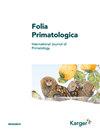广泛分布和表型隐蔽的北小加拉戈(Galago senegalensis)响亮叫声的低地理和亚种变异表明了分类学的一致性
IF 1.2
4区 生物学
Q2 ZOOLOGY
引用次数: 3
摘要
与其他夜间活动的灵长类动物一样,加拉戈(加拉戈科)的许多物种在表型上是隐蔽的,这使得它们的分类地位难以确定。最近的分类学工作已经解开了一些困惑。这导致了公认的加拉戈物种数量的增加。分布最广的加拉戈物种,事实上也是分布最广泛的夜间灵长类动物,是北部小加拉戈(galago senegalensis),其地理范围横跨非洲7000公里以上。根据形态学,目前已识别出4个亚种:G.s.senegalensis、G.s.braccatus、G.s.sotikae和G.s.dunni。我们探索了塞内加尔G.senegalensis的地理和亚种声学变异,检验了三个假设:距离隔离、遗传基础和屏障隔离。对于4个呼叫参数中的2个(基频和单位长度),有按距离隔离的统计支持。地理距离可以解释适度的声学变化。判别函数分析提供了地理区域和亚种的一定程度的分离,但错误识别的百分比很高。尽管具有(假定的)准爱国主义地理范围,但最明显的声学差异是在G.s.senegalensis和G.s.dunni之间。研究结果表明,东非大裂谷和尼日尔河是塞内加尔G.senegalensis的重要屏障。来自28个分布广泛的地点的121个人的大声叫声的声学结构没有显著差异。尽管这使得在采样地点,塞内加尔G.senegalensis内不太可能出现更多未被识别的物种,但该地理范围的大片地区仍未采样。我们发现,范围广泛的物种并不一定在它们的声乐曲目中表现出大量的变化。这种模式也可能存在于地理范围较小的夜间灵长类动物中。本文章由计算机程序翻译,如有差异,请以英文原文为准。
Low Geographic and Subspecific Variation in the Loud Call of the Widespread and Phenotypically Cryptic Northern Lesser Galago (Galago senegalensis) Suggests Taxonomic Uniformity
Like other nocturnal primates, many species of galago (Galagidae) are phenotypically cryptic, making their taxonomic status difficult to resolve. Recent taxonomic work has disentangled some of the confusion. This has resulted in an increase in the number of recognised galago species. The most widespread galago species, and indeed the most widespread nocturnal primate, is the northern lesser galago (Galago senegalensis) whose geographic range stretches >7,000 km across Africa. Based on morphology, 4 subspecies are currently recognised: G. s. senegalensis, G. s. braccatus, G. s. sotikae and G. s. dunni. We explore geographic and subspecific acoustic variation in G. senegalensis, testing three hypotheses: isolation by distance, genetic basis, and isolation by barrier. There is statistical support for isolation by distance for 2 of 4 call parameters (fundamental frequency and unit length). Geographic distance explains a moderate amount of the acoustic variation. Discriminant function analysis provides some degree of separation of geographic regions and subspecies, but the percentage of misdesignation is high. Despite having (putative) parapatric geographic ranges, the most pronounced acoustic differences are between G. s. senegalensis and G. s. dunni. The findings suggest that the Eastern Rift Valley and Niger River are significant barriers for G. senegalensis. The acoustic structures of the loud calls of 121 individuals from 28 widespread sites are not significantly different. Although this makes it unlikely that additional unrecognised species occur within G. senegalensis at the sites sampled, vast areas of the geographic range remain unsampled. We show that wide-ranging species do not necessarily exhibit large amounts of variation in their vocal repertoire. This pattern may also be present in nocturnal primates with smaller geographic ranges.
求助全文
通过发布文献求助,成功后即可免费获取论文全文。
去求助
来源期刊

Folia Primatologica
生物-动物学
CiteScore
3.30
自引率
10.50%
发文量
36
审稿时长
>12 weeks
期刊介绍:
Recognizing that research in human biology must be founded on a comparative knowledge of our closest relatives, this journal is the natural scientist''s ideal means of access to the best of current primate research. ''Folia Primatologica'' covers fields as diverse as molecular biology and social behaviour, and features articles on ecology, conservation, palaeontology, systematics and functional anatomy. In-depth articles and invited reviews are contributed by the world’s leading primatologists. In addition, special issues provide rapid peer-reviewed publication of conference proceedings. ''Folia Primatologica'' is one of the top-rated primatology publications and is acknowledged worldwide as a high-impact core journal for primatologists, zoologists and anthropologists.
 求助内容:
求助内容: 应助结果提醒方式:
应助结果提醒方式:


